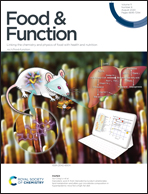The opposite effects of Antarctic krill oil and arachidonic acid-rich oil on bone resorption in ovariectomized mice
Abstract
Osteoporosis, a chronic disease that affects over 200 million people worldwide, presents a substantial medical and socioeconomic burden on the modern society. However, long-term intake of diets supplemented with different polyunsaturated fatty acids (PUFAs) can affect bone metabolism; thus, this study investigated the comparative effects of Antarctic krill oil (AKO, containing n-3 PUFAs) and arachidonic acid-rich oil (AAO, containing n-6 PUFAs) on bone resorption in a mice model of postmenopausal osteoporosis. Mice were orally administered with AKO (200 mg kg−1) or AAO (220 mg kg−1) once daily for 30 days, ovariectomized, followed by the continued administration of the respective samples for 90 days. Biomechanical and histomorphometric analyses revealed that AKO increased the bone mineral density (BMD) to enhance the biomechanical properties by increasing the mineral apposition rate and repairing the microstructure of the trabecular bone, whereas AAO had the opposite effect. The fatty acid analysis of the vertebra showed that AKO increased the n-3 PUFA (especially for DHA) content, thereby decreasing the ratio of n-6/n-3 PUFAs, which was negatively correlated with the BMD. However, AAO had the opposite effect due to high amounts of arachidonic acid. To explore the underlying mechanism responsible for these observations, we compared the classical bone resorption OPG/RANKL/NF-κB pathway mediated by PGE2/EP4. The ratio of n-6/n-3 PUFAs in the bone affected the production of PGE2, a factor regulating the OPG/RANKL pathway, thereby regulating osteoclastogenesis by stimulating the NF-κB pathway. The results of ELISA, qRT-PCR, and western blot demonstrated that AKO reduced the secretion of PGE2 and the expression of EP4, upregulating the ratio of OPG/RANKL in the bone, thereby decreasing TRAF6 expression to inhibit the activation of the NF-κB signaling pathway, and finally inhibiting the expression of nuclear transcription factors (c-fos and NFATc1) to prevent excessive osteoclastogenesis (TRACP, MMP-9, and Cath-K). Arachidonic acid is a precursor of PGE2 synthesis. AAO showed the opposite trend through the same pathway. Thus, AKO could significantly improve osteoporosis via the OPG/RANKL/NF-κB pathway mediated by PGE2/EP4 to inhibit osteoclastogenesis, whereas AAO aggravated osteoporosis via the same pathway. This is the first study to systematically compare the effects and mechanism of AKO and AAO in regulating bone resorption in osteoporotic mice to support recommendations on fatty acid types in dietary oils for an osteoporotic population.



 Please wait while we load your content...
Please wait while we load your content...